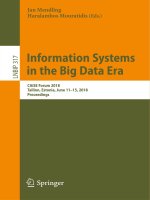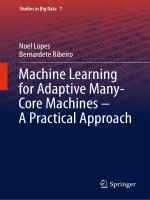Big data in practice (mrkiven0)
Bạn đang xem bản rút gọn của tài liệu. Xem và tải ngay bản đầy đủ của tài liệu tại đây (2.27 MB, 323 trang )
“Amazing. That was my first word, when I started reading this book. Fascinating
was the next. Amazing, because once again, Bernard masterfully takes a complex subject, and translates it into something anyone can understand. Fascinating because the detailed real-life customer examples immediately inspired me
to think about my own customers and partners, and how they could emulate
the success of these companies. Bernard’s book is a must have for all Big Data
practitioners and Big Data hopefuls!”
Shawn Ahmed, Senior Director, Business Analytics and IoT at Splunk
“Finally a book that stops talking theory and starts talking facts. Providing reallife and tangible insights for practices, processes, technology and teams that support Big Data, across a portfolio of organizations and industries. We often think
Big Data is big business and big cost, however some of the most interesting examples show how small businesses can use smart data to make a real difference. The
businesses in the book illustrate how Big Data is fundamentally about the customer, and generating a data-driven customer strategy that influences both staff
and customers at every touch point of the customer journey.”
Adrian Clowes, Head of Data and Analytics at Center Parcs UK
“Big Data in Practice by Bernard Marr is the most complete book on the Big Data
and analytics ecosystem. The many real-life examples make it equally relevant for
the novice as well as experienced data scientists.”
Fouad Bendris, Business Technologist, Big Data Lead at Hewlett Packard
Enterprise
“Bernard Marr is one of the leading authors in the domain of Big Data. Throughout Big Data in Practice Marr generously shares some of his keen insights into the
practical value delivered to a huge range of different businesses from their Big
Data initiatives. This fascinating book provides excellent clues as to the secret
sauce required in order to successfully deliver competitive advantage through
Big Data analytics. The logical structure of the book means that it is as easy to
consume in one sitting as it is to pick up from time to time. This is a must-read
for any Big Data sceptics or business leaders looking for inspiration.”
Will Cashman, Head of Customer Analytics at AIB
“The business of business is now data! Bernard Marr’s book delivers concrete,
valuable, and diverse insights on Big Data use cases, success stories, and lessons
learned from numerous business domains. After diving into this book, you will
have all the knowledge you need to crush the Big Data hype machine, to soar to
new heights of data analytics ROI, and to gain competitive advantage from the
data within your organization.”
Kirk Borne, Principal Data Scientist at Booz Allen Hamilton, USA
“Big Data is disrupting every aspect of business. You’re holding a book that provides powerful examples of how companies strive to defy outmoded business
models and design new ones with Big Data in mind.”
Henrik von Scheel, Google Advisory Board Member
“Bernard Marr provides a comprehensive overview of how far Big Data has come
in past years. With inspiring examples he clearly shows how large, and small,
organizations can benefit from Big Data. This book is a must-read for any organization that wants to be a data-driven business.”
Mark van Rijmenam, Author Think Bigger and Founder of Datafloq
“This is one of those unique business books that is as useful as it is interesting.
Bernard has provided us with a unique, inside look at how leading organizations
are leveraging new technology to deliver real value out of data and completely
transforming the way we think, work, and live.”
Stuart Frankel, CEO at Narrative Science Inc.
“Big Data can be a confusing subject for even sophisticated data analysts. Bernard has done a fantastic job of illustrating the true business benefits
of Big Data. In this book you find out succinctly how leading companies are
getting real value from Big Data – highly recommended read!’
Arthur Lee, Vice President of Qlik Analytics at Qlik
“If you are searching for the missing link between Big Data technology and
achieving business value – look no further! From the world of science to entertainment, Bernard Marr delivers it – and, importantly, shares with us the recipes
for success.”
Achim Granzen, Chief Technologist Analytics at Hewlett Packard
Enterprise
“A comprehensive compendium of why, how, and to what effects Big Data analytics are used in today’s world.”
James Kobielus, Big Data Evangelist at IBM
“A treasure chest of Big Data use cases.”
Stefan Groschupf, CEO at Datameer, Inc.
BIG DATA IN PRACTICE
BIG DATA IN
PRACTICE
HOW 45 SUCCESSFUL
COMPANIES USED BIG DATA
ANALYTICS TO DELIVER
EXTRAORDINARY RESULTS
BERNARD MARR
This edition first published 2016
© 2016 Bernard Marr
Registered office
John Wiley and Sons Ltd, The Atrium, Southern Gate, Chichester, West Sussex, PO19 8SQ,
United Kingdom
For details of our global editorial offices, for customer services and for information about how to
apply for permission to reuse the copyright material in this book please see our website at
www.wiley.com.
The right of the author to be identified as the author of this work has been asserted in
accordance with the Copyright, Designs and Patents Act 1988.
All rights reserved. No part of this publication may be reproduced, stored in a retrieval system,
or transmitted, in any form or by any means, electronic, mechanical, photocopying, recording or
otherwise, except as permitted by the UK Copyright, Designs and Patents Act 1988, without the
prior permission of the publisher.
Wiley publishes in a variety of print and electronic formats and by print-on-demand. Some
material included with standard print versions of this book may not be included in e-books or in
print-on-demand. If this book refers to media such as a CD or DVD that is not included in the
version you purchased, you may download this material at . For
more information about Wiley products, visit www.wiley.com.
Designations used by companies to distinguish their products are often claimed as trademarks.
All brand names and product names used in this book and on its cover are trade names, service
marks, trademarks or registered trademarks of their respective owners. The publisher and the
book are not associated with any product or vendor mentioned in this book. None of the
companies referenced within the book have endorsed the book.
Limit of Liability/Disclaimer of Warranty: While the publisher and author have used their best
efforts in preparing this book, they make no representations or warranties with respect to the
accuracy or completeness of the contents of this book and specifically disclaim any implied
warranties of merchantability or fitness for a particular purpose. It is sold on the understanding
that the publisher is not engaged in rendering professional services and neither the publisher nor
the author shall be liable for damages arising herefrom. If professional advice or other expert
assistance is required, the services of a competent professional should be sought.
Library of Congress Cataloging-in-Publication Data is available
A catalogue record for this book is available from the British Library.
ISBN 978-1-119-23138-7 (hbk)
ISBN 978-1-119-23141-7 (ebk)
ISBN 978-1-119-23139-4 (ebk)
ISBN 978-1-119-27882-5 (ebk)
Cover Design: Wiley
Cover Image: © vs148/Shutterstock
Set in 11/14pt MinionPro Light by Aptara Inc., New Delhi, India
Printed in Great Britain by TJ International Ltd, Padstow, Cornwall, UK
This book is dedicated to the people who mean most to me: My wife
Claire and our three children Sophia, James and Oliver.
CONTENTS
1
2
3
4
5
6
7
8
9
10
11
12
13
14
15
16
Introduction
Walmart: How Big Data Is Used To Drive Supermarket
Performance
CERN: Unravelling The Secrets Of The Universe
With Big Data
Netflix: How Netflix Used Big Data To Give Us The
Programmes We Want
Rolls-Royce: How Big Data Is Used To Drive Success In
Manufacturing
Shell: How Big Oil Uses Big Data
Apixio: How Big Data Is Transforming Healthcare
Lotus F1 Team: How Big Data Is Essential To The
Success Of Motorsport Teams
Pendleton & Son Butchers: Big Data For Small Business
US Olympic Women’s Cycling Team: How Big Data
Analytics Is Used To Optimize Athletes’ Performance
ZSL: Big Data In The Zoo And To Protect Animals
Facebook: How Facebook Use Big Data To Understand
Customers
John Deere: How Big Data Can Be Applied On Farms
Royal Bank of Scotland: Using Big Data To Make
Customer Service More Personal
LinkedIn: How Big Data Is Used To Fuel Social
Media Success
Microsoft: Bringing Big Data To The Masses
Acxiom: Fuelling Marketing With Big Data
ix
1
5
11
17
25
31
37
45
51
57
63
69
75
81
87
95
103
CONTENTS
17
18
19
20
21
22
23
24
25
26
27
28
29
30
31
32
33
34
35
36
37
38
US Immigration And Customs: How Big Data Is Used
To Keep Passengers Safe And Prevent Terrorism
Nest: Bringing The Internet of Things Into The Home
GE: How Big Data Is Fuelling The Industrial Internet
Etsy: How Big Data Is Used In A Crafty Way
Narrative Science: How Big Data Is Used To Tell Stories
BBC: How Big Data Is Used In The Media
Milton Keynes: How Big Data Is Used To Create
Smarter Cities
Palantir: How Big Data Is Used To Help The CIA And
To Detect Bombs In Afghanistan
Airbnb: How Big Data Is Used To Disrupt The
Hospitality Industry
Sprint: Profiling Audiences Using Mobile Network Data
Dickey’s Barbecue Pit: How Big Data Is Used To Gain
Performance Insights Into One Of America’s Most
Successful Restaurant Chains
Caesars: Big Data At The Casino
Fitbit: Big Data In The Personal Fitness Arena
Ralph Lauren: Big Data In The Fashion Industry
Zynga: Big Data In The Gaming Industry
Autodesk: How Big Data Is Transforming The
Software Industry
Walt Disney Parks and Resorts: How Big Data Is
Transforming Our Family Holidays
Experian: Using Big Data To Make Lending Decisions
And To Crack Down On Identity Fraud
Transport for London: How Big Data Is Used To
Improve And Manage Public Transport In London
The US Government: Using Big Data To Run A Country
IBM Watson: Teaching Computers To Understand
And Learn
Google: How Big Data Is At The Heart Of Google’s
Business Model
x
111
117
125
131
137
143
149
157
163
169
175
181
189
195
199
205
211
217
223
229
237
243
CONTENTS
39
40
41
42
43
44
45
Terra Seismic: Using Big Data To Predict Earthquakes
Apple: How Big Data Is At The Centre Of Their Business
Twitter: How Twitter And IBM Deliver Customer
Insights From Big Data
Uber: How Big Data Is At The Centre Of Uber’s
Transportation Business
Electronic Arts: Big Data In Video Gaming
Kaggle: Crowdsourcing Your Data Scientist
Amazon: How Predictive Analytics Are Used To Get A
360-Degree View Of Consumers
Final Thoughts
About the Author
Acknowledgements
Index
251
255
261
267
273
281
287
293
297
299
301
xi
INTRODUCTION
We are witnessing a movement that will completely transform any
part of business and society. The word we have given to this movement is Big Data and it will change everything, from the way banks
and shops operate to the way we treat cancer and protect our world
from terrorism. No matter what job you are in and no matter what
industry you work in, Big Data will transform it.
Some people believe that Big Data is just a big fad that will go away
if they ignore it for long enough. It won’t! The hype around Big Data
and the name may disappear (which wouldn’t be a great loss), but the
phenomenon will stay and only gather momentum. What we call Big
Data today will simply become the new normal in a few years’ time,
when all businesses and government organizations use large volumes
of data to improve what they do and how they do it.
I work every day with companies and government organizations on
Big Data projects and thought it would be a good idea to share how
Big Data is used today, across lots of different industries, among big
and small companies, to deliver real value. But first things first, let’s
just look at what Big Data actually means.
What Is Big Data?
Big Data basically refers to the fact that we can now collect and analyse
data in ways that was simply impossible even a few years ago. There
1
BIG DATA IN PRACTICE
are two things that are fuelling this Big Data movement: the fact we
have more data on anything and our improved ability to store and
analyse any data.
More Data On Everything
Everything we do in our increasingly digitized world leaves a data
trail. This means the amount of data available is literally exploding.
We have created more data in the past two years than in the entire
previous history of mankind. By 2020, it is predicted that about
1.7 megabytes of new data will be created every second, for every
human being on the planet. This data is coming not just from the tens
of millions of messages and emails we send each other every second
via email, WhatsApp, Facebook, Twitter, etc. but also from the one
trillion digital photos we take each year and the increasing amounts
of video data we generate (every single minute we currently upload
about 300 hours of new video to YouTube and we share almost three
million videos on Facebook). On top of that, we have data from
all the sensors we are now surrounded by. The latest smartphones
have sensors to tell where we are (GPS), how fast we are moving
(accelerometer), what the weather is like around us (barometer),
what force we are using to press the touch screen (touch sensor)
and much more. By 2020, we will have over six billion smartphones
in the world – all full of sensors that collect data. But not only our
phones are getting smart, we now have smart TVs, smart watches,
smart meters, smart kettles, fridges, tennis rackets and even smart
light bulbs. In fact, by 2020, we will have over 50 billion devices that
are connected to the Internet. All this means that the amount of data
and the variety of data (from sensor data, to text and video) in the
world will grow to unimaginable levels.
Ability To Analyse Everything
All this Big Data is worth very little unless we are able to turn it into
insights. In order to do that we need to capture and analyse the data.
2
INTRODUCTION
In the past, there were limitations to the amount of data that could be
stored in databases – the more data there was, the slower the system
became. This can now be overcome with new techniques that allow
us to store and analyse data across different databases, in distributed
locations, connected via networks. So-called distributed computing
means huge amounts of data can be stored (in little bits across lots
of databases) and analysed by sharing the analysis between different
servers (each performing a small part of the analysis).
Google were instrumental in developing distributed computing technology, enabling them to search the Internet. Today, about 1000 computers are involved in answering a single search query, which takes no
more than 0.2 seconds to complete. We currently search 3.5 billion
times a day on Google alone.
Distributed computing tools such as Hadoop manage the storage and
analysis of Big Data across connected databases and servers. What’s
more, Big Data storage and analysis technology is now available to
rent in a software-as-a-service (SAAS) model, which makes Big Data
analytics accessible to anyone, even those with low budgets and limited IT support.
Finally, we are seeing amazing advancements in the way we can analyse data. Algorithms can now look at photos, identify who is on them
and then search the Internet for other pictures of that person. Algorithms can now understand spoken words, translate them into written text and analyse this text for content, meaning and sentiment (e.g.
are we saying nice things or not-so-nice things?). More and more
advanced algorithms emerge every day to help us understand our
world and predict the future. Couple all this with machine learning
and artificial intelligence (the ability of algorithms to learn and make
decisions independently) and you can hopefully see that the developments and opportunities here are very exciting and evolving very
quickly.
3
BIG DATA IN PRACTICE
Big Data Opportunities
With this book I wanted to showcase the current state of the art in Big
Data and provide an overview of how companies and organizations
across all different industries are using Big Data to deliver value in
diverse areas. You will see I have covered areas including how retailers
(both traditional bricks ’n’ mortar companies as well as online ones)
use Big Data to predict trends and consumer behaviours, how governments are using Big Data to foil terrorist plots, even how a tiny
family butcher or a zoo use Big Data to improve performance, as well
as the use of Big Data in cities, telecoms, sports, gambling, fashion,
manufacturing, research, motor racing, video gaming and everything
in between.
Instead of putting their heads in the sand or getting lost in this
startling new world of Big Data, the companies I have featured here
have figured out smart ways to use data in order to deliver strategic
value. In my previous book, Big Data: Using SMART Big Data, Analytics and Metrics to Make Better Decisions and Improve Performance
(also published by Wiley), I go into more detail on how any company
can figure out how to use Big Data to deliver value.
I am convinced that Big Data, unlike any other trend at the moment,
will affect everyone and everything we do. You can read this book
cover to cover for a complete overview of current Big Data use cases
or you can use it as a reference book and dive in and out of the areas
you find most interesting or are relevant to you or your clients. I hope
you enjoy it!
4
1
WALMART
How Big Data Is Used To Drive Supermarket
Performance
Background
Walmart are the largest retailer in the world and the world’s largest
company by revenue, with over two million employees and 20,000
stores in 28 countries.
With operations on this scale it’s no surprise that they have long seen
the value in data analytics. In 2004, when Hurricane Sandy hit the
US, they found that unexpected insights could come to light when
data was studied as a whole, rather than as isolated individual sets.
Attempting to forecast demand for emergency supplies in the face
of the approaching Hurricane Sandy, CIO Linda Dillman turned up
some surprising statistics. As well as flashlights and emergency equipment, expected bad weather had led to an upsurge in sales of strawberry Pop Tarts in several other locations. Extra supplies of these were
dispatched to stores in Hurricane Frances’s path in 2012, and sold
extremely well.
Walmart have grown their Big Data and analytics department considerably since then, continuously staying on the cutting edge. In
2015, the company announced they were in the process of creating
5
BIG DATA IN PRACTICE
the world’s largest private data cloud, to enable the processing of 2.5
petabytes of information every hour.
What Problem Is Big Data Helping To Solve?
Supermarkets sell millions of products to millions of people every
day. It’s a fiercely competitive industry which a large proportion of
people living in the developed world count on to provide them with
day-to-day essentials. Supermarkets compete not just on price but
also on customer service and, vitally, convenience. Having the right
products in the right place at the right time, so the right people can
buy them, presents huge logistical problems. Products have to be efficiently priced to the cent, to stay competitive. And if customers find
they can’t get everything they need under one roof, they will look
elsewhere for somewhere to shop that is a better fit for their busy
schedule.
How Is Big Data Used In Practice?
In 2011, with a growing awareness of how data could be used to
understand their customers’ needs and provide them with the products they wanted to buy, Walmart established @WalmartLabs and
their Fast Big Data Team to research and deploy new data-led initiatives across the business.
The culmination of this strategy was referred to as the Data Caf´e –
a state-of-the-art analytics hub at their Bentonville, Arkansas headquarters. At the Caf´e, the analytics team can monitor 200 streams
of internal and external data in real time, including a 40-petabyte
database of all the sales transactions in the previous weeks.
Timely analysis of real-time data is seen as key to driving business performance – as Walmart Senior Statistical Analyst Naveen Peddamail
tells me: “If you can’t get insights until you’ve analysed your sales for
a week or a month, then you’ve lost sales within that time.
6
WALMART
“Our goal is always to get information to our business partners as fast
as we can, so they can take action and cut down the turnaround time.
It is proactive and reactive analytics.”
Teams from any part of the business are invited to visit the Caf´e with
their data problems, and work with the analysts to devise a solution.
There is also a system which monitors performance indicators across
the company and triggers automated alerts when they hit a certain
level – inviting the teams responsible for them to talk to the data team
about possible solutions.
Peddamail gives an example of a grocery team struggling to understand why sales of a particular produce were unexpectedly declining.
Once their data was in the hands of the Caf´e analysts, it was established very quickly that the decline was directly attributable to a pricing error. The error was immediately rectified and sales recovered
within days.
Sales across different stores in different geographical areas can also
be monitored in real-time. One Halloween, Peddamail recalls, sales
figures of novelty cookies were being monitored, when analysts saw
that there were several locations where they weren’t selling at all. This
enabled them to trigger an alert to the merchandizing teams responsible for those stores, who quickly realized that the products hadn’t
even been put on the shelves. Not exactly a complex algorithm, but it
wouldn’t have been possible without real-time analytics.
Another initiative is Walmart’s Social Genome Project, which monitors public social media conversations and attempts to predict what
products people will buy based on their conversations. They also
have the Shopycat service, which predicts how people’s shopping
habits are influenced by their friends (using social media data again)
and have developed their own search engine, named Polaris, to
allow them to analyse search terms entered by customers on their
websites.
7
BIG DATA IN PRACTICE
What Were The Results?
Walmart tell me that the Data Caf´e system has led to a reduction in
the time it takes from a problem being spotted in the numbers to a
solution being proposed from an average of two to three weeks down
to around 20 minutes.
What Data Was Used?
The Data Caf´e uses a constantly refreshed database consisting of
200 billion rows of transactional data – and that only represents the
most recent few weeks of business!
On top of that it pulls in data from 200 other sources, including meteorological data, economic data, telecoms data, social media data, gas
prices and a database of events taking place in the vicinity of Walmart
stores.
What Are The Technical Details?
Walmart’s real-time transactional database consists of 40 petabytes of
data. Huge though this volume of transactional data is, it only includes
from the most recent weeks’ data, as this is where the value, as far as
real-time analysis goes, is to be found. Data from across the chain’s
stores, online divisions and corporate units are stored centrally on
Hadoop (a distributed data storage and data management system).
CTO Jeremy King has described the approach as “data democracy”
as the aim is to make it available to anyone in the business who
can make use of it. At some point after the adoption of distributed
Hadoop framework in 2011, analysts became concerned that the volume was growing at a rate that could hamper their ability to analyse
it. As a result, a policy of “intelligently managing” data collection was
adopted which involved setting up several systems designed to refine
and categorize the data before it was stored. Other technologies in use
8
WALMART
include Spark and Cassandra, and languages including R and SAS are
used to develop analytical applications.
Any Challenges That Had To Be Overcome?
With an analytics operation as ambitious as the one planned by
Walmart, the rapid expansion required a large intake of new staff,
and finding the right people with the right skills proved difficult.
This problem is far from restricted to Walmart: a recent survey by
researchers Gartner found that more than half of businesses feel their
ability to carry out Big Data analytics is hampered by difficulty in hiring the appropriate talent.
One of the approaches Walmart took to solving this was to turn to
crowdsourced data science competition website Kaggle – which I profile in Chapter 44.1
Kaggle set users of the website a challenge involving predicting how
promotional and seasonal events such as stock-clearance sales and
holidays would influence sales of a number of different products.
Those who came up with models that most closely matched the reallife data gathered by Walmart were invited to apply for positions on
the data science team. In fact, one of those who found himself working for Walmart after taking part in the competition was Naveen Peddamail, whose thoughts I have included in this chapter.
Once a new analyst starts at Walmart, they are put through their Analytics Rotation Program. This sees them moved through each different team with responsibility for analytical work, to allow them to gain
a broad overview of how analytics is used across the business.
Walmart’s senior recruiter for its Information Systems Operation,
Mandar Thakur, told me: “The Kaggle competition created a buzz
about Walmart and our analytics organization. People always knew
9
BIG DATA IN PRACTICE
that Walmart generates and has a lot of data, but the best part was
that this let people see how we are using it strategically.”
What Are The Key Learning Points
And Takeaways?
Supermarkets are big, fast, constantly changing businesses that are
complex organisms consisting of many individual subsystems. This
makes them an ideal business in which to apply Big Data analytics.
Success in business is driven by competition. Walmart have always
taken a lead in data-driven initiatives, such as loyalty and reward programmes, and by wholeheartedly committing themselves to the latest
advances in real-time, responsive analytics they have shown they plan
to remain competitive.
Bricks ‘n’ mortar retail may be seen as “low tech” – almost Stone Age,
in fact – compared to their flashy, online rivals but Walmart have
shown that cutting-edge Big Data is just as relevant to them as it is to
Amazon or Alibaba.2 Despite the seemingly more convenient options
on offer, it appears that customers, whether through habit or preference, are still willing to get in their cars and travel to shops to buy
things in person. This means there is still a huge market out there for
the taking, and businesses that make best use of analytics in order to
drive efficiency and improve their customers’ experience are set to
prosper.
REFERENCES AND FURTHER READING
1. Kaggle (2015) Predict how sales of weather-sensitive products are
affected by snow and rain, accessed 5 January 2016.
2. Walmart (2015) When data met retail: A #lovedata story, http://
careersblog.walmart.com/when-data-met-retail-a-lovedata-story/,
accessed 5 January 2016.
10
2
CERN
Unravelling The Secrets Of The Universe
With Big Data
Background
CERN are the international scientific research organization that operate the Large Hadron Collider (LHC), humanity’s biggest and most
advanced physics experiment. The colliders, encased in 17 miles of
tunnels buried 600 feet below the surface of Switzerland and France,
aim to simulate conditions in the universe milliseconds following the
Big Bang. This allows physicists to search for elusive theoretical particles, such as the Higgs boson, which could give us unprecedented
insight into the composition of the universe.
CERN’s projects, such as the LHC, would not be possible if it weren’t
for the Internet and Big Data – in fact, the Internet was originally created at CERN in the 1990s. Tim Berners-Lee, the man often referred
to as the “father of the Internet”, developed the hypertext protocol
which holds together the World Wide Web while at CERN. Its original
purpose was to facilitate communication between researchers around
the globe.
The LHC alone generates around 30 petabytes of information per
year – 15 trillion pages of printed text, enough to fill 600 million filling cabinets – clearly Big Data by anyone’s standards!
11









